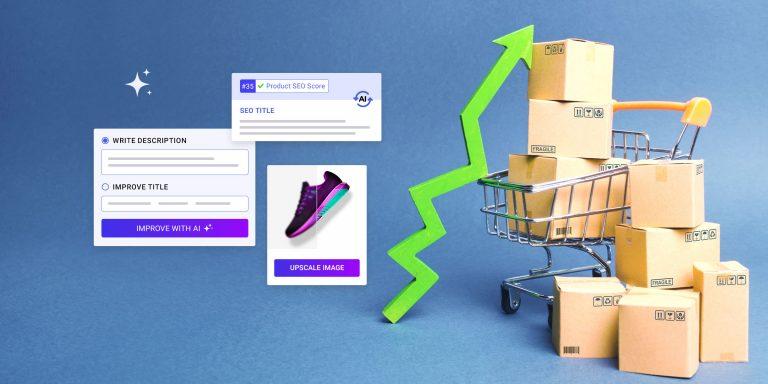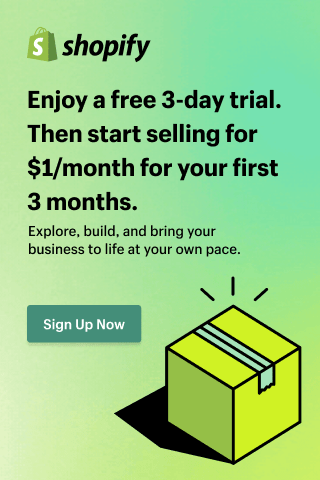Getting plenty of users visiting your store, but not seeing them take the actions you want? The right conversion strategies can change all that.
In this article, we’ll discuss how to increase the conversion rate for your ecommerce store through diverse strategies. We’ll also dive into the common pitfalls and show you how to fix them.
By the end, you’ll have the toolbox to turn those users into paying customers and increase your ecommerce store sales.
Table of Contents
7 Best strategies to increase your ecommerce store’s conversion rate
As you read on, copy the practical points that resonate most with your ecommerce store, then flag key areas in your conversion funnel for immediate tweaks.
1. Fine-tune your product pages to trigger buying decisions
This goes beyond just making your product pages look good; it’s about strategically shaping them to guide potential customers toward a purchase. Use these pages to create an online store experience that removes doubts, answers questions, and taps into their emotions until they finally convert.
How to do it
Do not just list your product’s features—explain how each feature benefits your customers. For example, instead of just saying “100% cotton fabric,” describe how it feels soft on the skin and is breathable for all-day comfort. Let customers understand exactly what they’re getting and why it matters to them.
High-quality product images are non-negotiable too. You should show your items from different angles. For example, highlight specific design elements, materials used, or the product’s dimensions. This transparency helps customers feel confident that what they see online is exactly what they’ll get.
To help you with this, use AppScenic to write product descriptions with compelling CTAs and optimize images in bulk.
You should also include customer reviews on your product pages to reassure new customers they’re making the right choice. To get the social proof, send surveys post-purchase or add a link on your website to make it easier for users to leave their feedback, like this:

Also, if your products require instructions to use, provide a clear step-by-step guide. If customers see how easy it is to use, they are more likely to convert.
Best for
This strategy is beneficial for all industries, but more so if you’re in the health and wellness niche selling supplements. Customers want and need to know exactly what they’re putting into their bodies.
My favorite example is Transparent Labs. They stand out since they don’t just list ingredients but clearly explain each one’s benefits. They connect science to real-life results. Their product pages also feature clear images, reviews, and trust badges.
Here’s how it looks for their Hydrate powder:

2. Create a virtual shopping event to drive instant sales
Let your target audience engage with your brand in real-time, just like they would in a physical store. You can use this to turn passive browsing into active participation.
Plus, these events create a sense of urgency and exclusivity, making online shoppers more likely to purchase right away. Virtual online shopping also makes their experience more interactive and exciting. Ultimately, all of these can help boost sales and conversion rates.
How to do it
Use tools like BrandLab360. Simply connect your ecommerce site with their platform to create a virtual version of your store. It can show real-time details on products, including stock, pricing, and sizing, like below.

Also, unlike other platforms, their virtual space lets your customers purchase directly and makes their shopping experience more seamless.
To further make your virtual event a success, offer event-exclusive discounts. You should also integrate a live chat or use BrandLab360’s AI virtual store assistant. Its AI avatar provides real-time, personalized assistance, similar to in-store help.
Best for
This strategy works best for industries like fashion, beauty, jewelry, and home decor. Here’s a great example from Burberry’s virtual store:
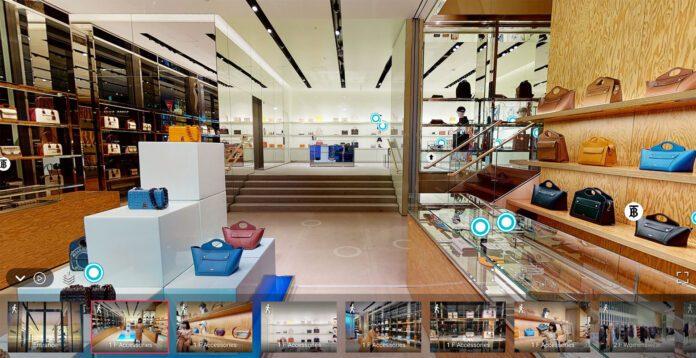
It’s a virtual replica of its Ginza, Japan store. To take it to the next level, they partnered with actress Elaiza Ikeda to produce 5 short styling tips videos that are available at various touch points within the virtual store.
3. Build a product quiz to match customers with their perfect fit
An interactive quiz is like giving your customers a personal shopper who understands exactly what they are looking for. It can engage them in a way that feels personalized and thoughtful, while also helping to improve your ecommerce conversion rate and online sales.
Additionally, a well-designed quiz can reduce decision fatigue and make it easier for your customers to find what they want without browsing endlessly.
How to do it
List down what you want to ask. You should tailor your questions to uncover customer preferences. Here are a few examples:
- Budget Range: What’s your ideal price range?
- Personalization: Do you prefer a specific style, color, or design?
- Feature Importance: Which features are most important to you?
Once you have your questions, use a tool like Outgrow to create your quiz. With its ready-to-use templates, you can craft a personalized quiz that guides your users through questions and ends with spot-on recommendations just for them.
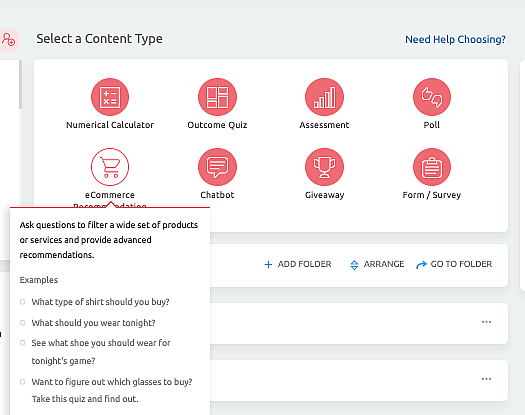
Now, it’s time to embed it in one of your web pages. You have many options here, like an in-page setup or a pop-up style.

But creating the recommendation quiz requires a lot more steps. Plus, the embedding can be tedious. So it’s best to hire an assistant who has experience with such marketing tools. They can import the products and apply logic to make your quizzes work as intended. Plus, an experienced marketing assistant will know where to place your quiz for maximum impact.
Best for
Online retailers in cosmetics, fashion, appliance, furniture, and fitness can benefit the most from a recommendation quiz type. One of my favorite examples is how Tailored Athlete does it. They offer a quiz that helps their athlete customers easily find the perfect smart casual or formal style.
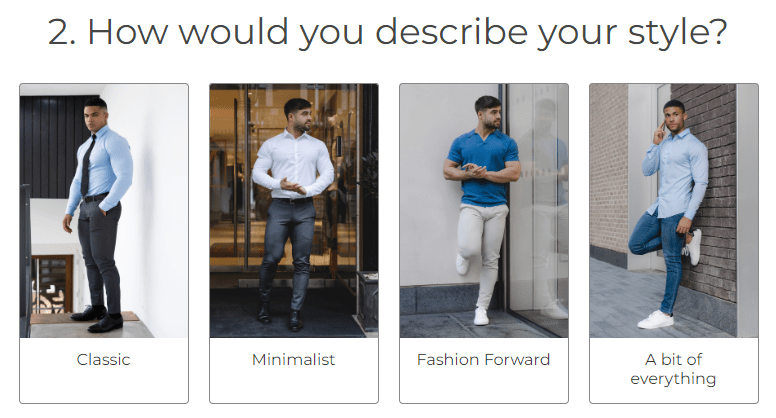
Unlike other brands, their quiz goes beyond just style preferences. It takes into account crucial details like chest size, body shape, and fit preferences to match users with attire that looks great and moves with their bodies. The quiz tailors the experience to the unique physical, style, comfort, and functionality needs of athletes.
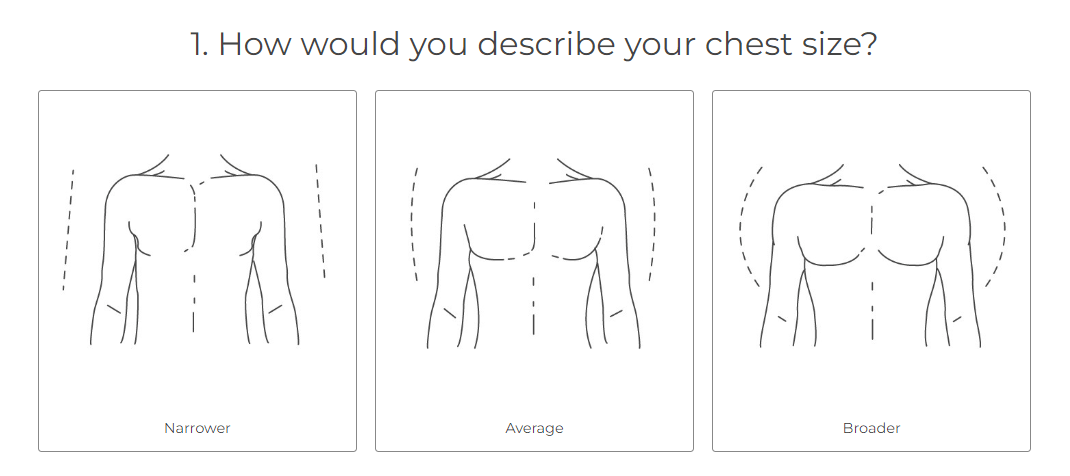
4. Simplify the checkout process to reduce cart abandonment
Single-page checkouts can increase ecommerce conversion rates by up to 21.8%.
So, make it easy and quick for customers to complete their purchases. Remove any friction that can make them abandon their cart. With this strategy, you keep them engaged until the end instead of frustrating them by adding unnecessary steps or asking way too many questions.
How to do it
To get started, you have to enable guest checkout. Reach out to your ecommerce platform or check their knowledge base, as the steps will differ depending on the platform you use. For example, if you’re using WooCommerce, you must go through this 6-step process to enable guest checkout.
Also, you should minimize checkout form fields. The fewer fields customers need to fill out, the quicker and easier their purchase will be. If you’re using WooCommerce, do this through their Checkout Field Editor plugin.
To make checkout even more simple, use Stripe to offer multiple payment options. This gives customers the flexibility to pay the way they prefer, which reduces drop-offs at the payment stage.

Best for
You can make this work no matter what ecommerce business you have. But it becomes even more important if you’re targeting seniors or older adults. They can find complex checkout forms overwhelming, so a smooth and simple process is essential to make sure they complete their purchase.
Here’s a great example when checking out LifeStation’s Sidekick Smart, one of the top-rated medical alert watches for seniors:
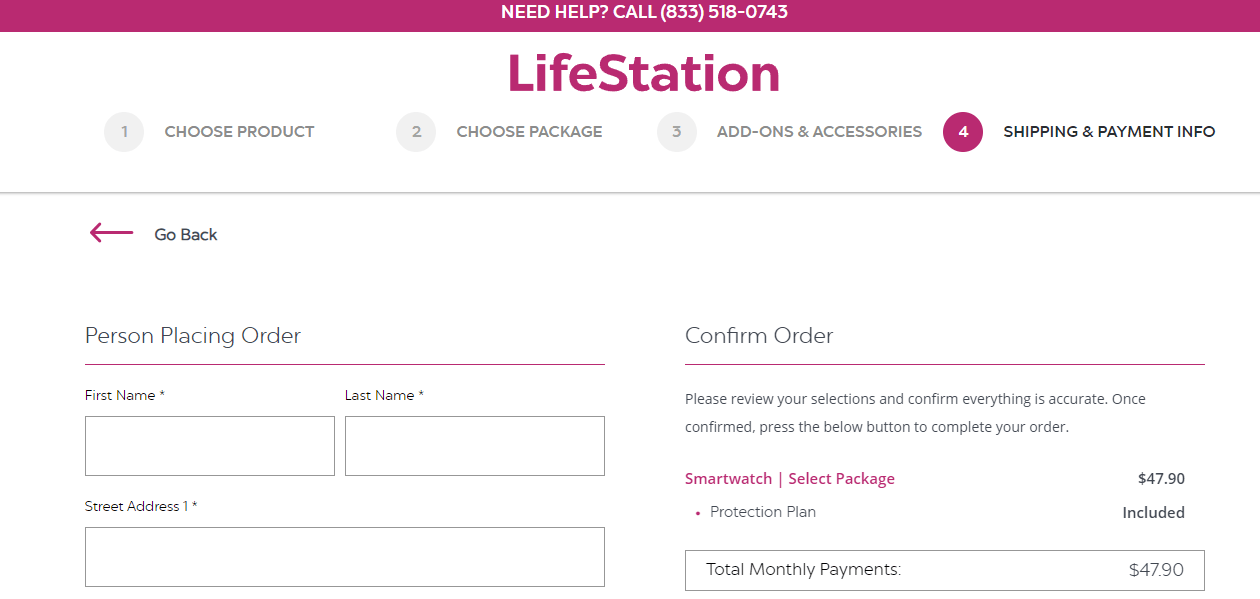
The checkout process is done in 4 simple steps, so it is smooth and easy for seniors or those buying for them. Plus, users can checkout as a guest.
5. Offer free shipping to close the deal
The average conversion rate for ecommerce hovers around 2.5% but with free shipping, you can tip the scale in your favor and increase these numbers.
Use it as a value proposition and remove one of the biggest barriers to completing a purchase: unexpected shipping costs. This makes it more attractive for the customers to choose your ecommerce website over others.
How to do it
First, analyze your pricing and adjust it slightly to cover shipping costs without losing profitability. For example, if you’re selling gourmet coffee, increase the price of each bag by a small amount to cover free shipping costs. This way, customers feel like they’re getting a deal with free shipping, while you maintain healthy profit margins and improve conversion rates.
Then, set a minimum purchase threshold. This means that free shipping only gets activated over a certain amount. With this, you can encourage customers to add more items to their cart, which boosts your average order value.
If you’re using Shopify, here’s how to set a minimum threshold:

When you have all that sorted, promote your free shipping offer sitewide and on social media. Create eye-catching banners so your customers know about the deal before they even start shopping.
Best for
This strategy is especially effective in industries that deal with large or heavy items, like big appliances, home decor, or outdoor gear. A great example of this is Pottery Barn. They have a dedicated page for items with free shipping, including bigger products:

6. Introduce bundles to encourage bigger purchases
When ecommerce businesses offer bundles at discounted prices, it improves the average order value. It also lets customers perceive that they’re getting more for less.
Plus, bundles make decision-making easier by giving a ready-made solution for the customer’s needs, offering everything they want in one convenient package.
How to do it
Use Google Analytics to identify which product pages are most visited. This gives you an idea of the ones your customers find most appealing. Here’s how to find this data on your GA4:
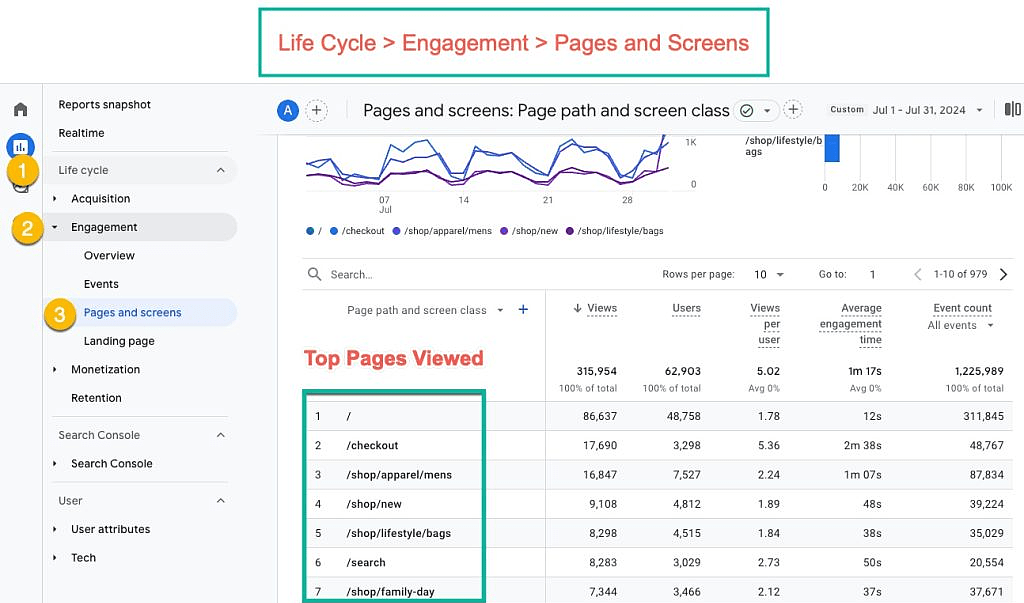
Additionally, you can use Putler to easily find frequently bought together items. Here’s how to use it:
- Sign in to your Putler account.
- Navigate to the Products dashboard.
- Select the product you want, and it will take you to the detailed information page for that product.
- Check the products listed under the “Frequently bought together” KPI.

Another option is to look at your product range and identify items that naturally go together. For example, If you’re selling skincare products, you can pair a facial cleanser with a moisturizer.
You can bundle your best-sellers and not-so-hot products too. This way, you can bring more attention to the latter and move its inventory. Also, gather insights from customer feedback to understand what products your customers often use together.
Best for
Bundles can increase ecommerce conversion rates in tech, beauty, skincare, and kitchenware since customers in these industries benefit from using multiple related products together. Here’s my favorite example:
Sugar Me Smooth’s Sugar Scrubs Bundles

What sets their bundles apart?
The brand tailors their bundles to match the season – scrub sets that are specifically designed for spring and summer. This approach makes their products feel fresh and relevant, encouraging users to buy items that are perfect for the season. This creates a sense of timeliness that many other brands don’t achieve with their more generic bundling approaches.
7. Leverage SEO to reach more customers
A well-executed SEO strategy connects you with customers actively searching for what you offer. This makes it easier to achieve your ecommerce conversion rate optimization goals. Plus, it helps you rank higher in search results, which improves your visibility on Google and other search engines.
How to do it
Start with keyword research. Use tools like Ahrefs to generate search term ideas that you can add to your content.
As you go through this process, it’s also important to take note of the long-tail keywords. These are specific, longer phrases that attract more targeted traffic. Here are examples:
- Vegan protein powder for women
- Best waterproof hiking boots for men
After you have your keyword list, create high-quality, relevant content – in-depth guides or blog posts that answer your customers’ questions. With this, you can attract more site visitors who trust your expertise, making them more likely to shop with you.
Additionally, you should improve your page load speed since Google favors fast-loading sites – those that load in less than 2 seconds. For this, you need to compress your images. Use TinyPNG to reduce image file sizes without sacrificing quality.
Reduce the number of elements on your pages too, like scripts and stylesheets. You can also combine or remove unnecessary ones to decrease the loading time.
Try to minify your CSS, JavaScript, and HTML files as well. Use tools like MinifyCode to remove unnecessary spaces, comments, and characters to make your code leaner and faster to load.
Now, that is just the tip of the iceberg, but as you can see, it can get highly technical. So it’s best to hire an SEO specialist to handle this for your website.
But if you’re curious about your ecommerce website’s page speed, just head over to Google PageSpeed Insights.
Best for
SEO is beneficial for any industry but it’s particularly effective for niches where customers often do thorough research before purchasing, like:
- Tech (ex. phones)
- Luxury home decor
- Automotive accessories
- Organic and natural items
- Health and wellness products
Pinch is a health and wellness brand that does SEO right. Here’s the brand topping the search results for the keyword ‘Chicago filler at home’:

How do they do that? Well, they make sure to insert relevant keywords, like lip fillers, dermal fillers, and at home, within their web pages. They also include ‘Chicago’ wherever they can, which boosts their local SEO since it’s where they’re located.

Plus, their fast page load speed is another reason they’re at the top of search results.

3 mistakes when trying to increase conversions & how to avoid them
Grab a notepad and mark 1 or 2 mistakes that apply to your store. Then, review the quick action plans we’re sharing to improve your ecommerce conversions right away.
A. Overlooking mobile optimization
Your ecommerce store has the potential to be one of the most lucrative endeavors, but if your site isn’t mobile-friendly, you’ll miss out big time. Think about it—mobile devices are where people scroll, shop, and decide to buy in the moment.
Mobile optimization gives you the chance to connect with customers when they’re most ready to purchase. With a seamless mobile experience, you can turn interest into conversion within seconds.
So, how do you avoid this mistake?
If you’re on Shopify, use the EComposer Landing Page Builder app.
Once you’re set-up, streamline your site’s menu and make sure the buttons and links are easy to tap on smaller screens.
Additionally, optimize your site for voice search since the likes of Siri are popular among mobile users. To do this, add natural language keywords and phrases into your content. For example, instead of just using the keyword ‘best running shoes,’ include natural phrases like:
- What are the best running shoes for flat feet?
- Show me top-rated running shoes for beginners.
You should optimize the checkout process too. Make sure forms are easy to fill out on small screens. Use larger input fields, auto-fill options, and minimal typing requirements. Plus, make sure you offer mobile payment options like Apple Pay or Google Wallet to help you further maintain a good ecommerce conversion rate.
B. Ignoring micro-conversions
Do not just focus only on major conversions (like purchases). You need to also take care of the micro-conversions, which are the small actions customers take on ecommerce websites like:
- Downloading a guide
- Signing up for a newsletter
- Adding a product to the cart
While they seem minor, these actions nurture potential buyers and engage them at every stage of their customer journey. Micro-conversions also build trust and guide them toward a purchase, giving you more sales in the long run.
Here are ways to optimize your ecommerce store for micro-conversions:
- Provide discounts or free shipping in exchange for newsletter sign-ups.
- Make it easy for customers to save products for later. A simple wish list button on product pages can help boost conversions.
- Make sure every micro-conversion has a clear, compelling call to action. Phrases like “Add to Wish List” or “Get Your Discount” should be prominent and persuasive to encourage more clicks.
C. Undervaluing customer care
When shopping online, customers can’t interact with a salesperson, so your customer service becomes their go-to resource. With exceptional customer care, you can solve their immediate problems and build trust. It also helps you turn first-time visitors into high-value customers.
To start improving, add a live chat feature. For many ecommerce websites, that means adding an advanced chatbot that can answer common queries, give personalized suggestions, and redirect customers to live agents.
This real-time support can reduce cart abandonment and improve conversions by providing quick solutions. Check out platforms like ChatBot to get services like these:

Another way to enhance your customer service is by following up with existing customers and making sure they’re satisfied. Personalized emails or messages show that you care about their experience, which can increase repeat business and lifetime value.
Conclusion
Now that you explored these strategies, how can you increase the conversion rate for your ecommerce ASAP? Well, take a moment to assess your ecommerce store’s current performance. Then, identify which tactics fit best with your immediate goals, whether it’s improving your SEO or refining your product pages. But remember, the key to finding success is to NOT do everything at once but focus on what will drive more conversions now.
To jumpstart the process, you can also partner up with AppScenic. Use our platform to optimize your product pages and make your ecommerce operations smoother. Start your free trial now and start increasing your conversion rates.
Author Bio: Christian Cabaluna is an SEO content writer with 5+ years of first-hand experience. When he isn’t writing in his favorite coffee shop, Christian enjoys reading (especially about psychology and neuroscience), cooking, watching documentaries, camping in the mountains, and catching beautiful sunsets.





